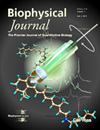Spatiotemporal dynamics of local anesthetic diffusion in nerve revealed by a 2D computational model.
IF 3.1
3区 生物学
Q2 BIOPHYSICS
引用次数: 0
Abstract
Despite their extensive clinical use, the intra-neural pharmacokinetics of local anesthetics, including the mechanisms determining their onset and duration, remain incompletely understood, particularly under pathological conditions. We developed a detailed, spatially-compartmentalized computational model of human peripheral nerve fascicles to simulate the diffusion, accumulation, and clearance kinetics of lidocaine and bupivacaine under physiological and acidic conditions. The model integrates nerve fiber architecture, extracellular fluid compartments, and capillary-mediated clearance, parameterized using experimentally validated anatomical and physicochemical data. It was implemented in Python 3.12, employing a fourth-order Runge-Kutta integrator via the SciPy library. The results revealed that onset is limited primarily by extracellular diffusion rather than transmembrane transport. Lidocaine reached the predefined onset threshold (≥50% of nerve fibers with ≥50% external concentration) at 8.7 s under physiological pH and 3.2 s under acidic conditions. Bupivacaine exhibited longer onset times, 79.2 s and 16.1 s, respectively. Acidic conditions markedly reduced equilibrium concentrations within nerve fibers (by 3.6-fold for lidocaine, 3.5-fold for bupivacaine), significantly shortening their durations of action (lidocaine: 758 to 233 s; bupivacaine: 6980 to 2059 s). These findings mirror known clinical efficacy reductions in inflamed or acidotic tissues. In conclusion, local anesthetic onset is primarily governed by extracellular diffusion rather than membrane permeability, rendering it largely independent of drug pKa. Local tissue acidosis reduces nerve fiber accumulation and accelerates anesthetic washout, thereby diminishing both efficacy and duration of action. These results explain longstanding clinical observations and suggest that nerve fibers act as kinetic reservoirs modulated by tissue pH. This computational model offers a valuable framework for predicting anesthetic behavior and optimizing drug delivery strategies in regional anesthesia, particularly under pathological conditions such as inflammation.局部麻醉在神经内扩散的时空动态二维计算模型。
尽管其广泛的临床应用,局部麻醉剂的神经内药代动力学,包括决定其起效和持续时间的机制,仍然不完全清楚,特别是在病理条件下。我们建立了一个详细的、空间划分的人类周围神经束计算模型来模拟生理和酸性条件下利多卡因和布比卡因的扩散、积累和清除动力学。该模型整合了神经纤维结构、细胞外液区室和毛细血管介导的清除,并使用实验验证的解剖和物理化学数据进行参数化。它是在Python 3.12中实现的,通过SciPy库使用四阶龙格-库塔积分器。结果显示,发病主要受细胞外扩散而非跨膜运输的限制。生理pH值为8.7 s,酸性条件下为3.2 s,利多卡因达到预设的起效阈值(≥50%的神经纤维,外部浓度≥50%)。布比卡因的起效时间较长,分别为79.2 s和16.1 s。酸性条件显著降低了神经纤维内的平衡浓度(利多卡因为3.6倍,布比卡因为3.5倍),显著缩短了它们的作用持续时间(利多卡因:758至233秒;布比卡因:6980至2059秒)。这些发现反映了已知的炎症或酸中毒组织的临床疗效下降。综上所述,局部麻醉的发生主要受细胞外扩散而非膜通透性的影响,因此在很大程度上与药物pKa无关。局部组织酸中毒减少神经纤维积聚,加速麻醉冲洗,从而减少疗效和作用时间。这些结果解释了长期的临床观察结果,并表明神经纤维作为由组织ph调节的动力储存器。该计算模型为预测麻醉行为和优化局部麻醉药物递送策略提供了有价值的框架,特别是在炎症等病理条件下。
本文章由计算机程序翻译,如有差异,请以英文原文为准。
求助全文
约1分钟内获得全文
求助全文
来源期刊

Biophysical journal
生物-生物物理
CiteScore
6.10
自引率
5.90%
发文量
3090
审稿时长
2 months
期刊介绍:
BJ publishes original articles, letters, and perspectives on important problems in modern biophysics. The papers should be written so as to be of interest to a broad community of biophysicists. BJ welcomes experimental studies that employ quantitative physical approaches for the study of biological systems, including or spanning scales from molecule to whole organism. Experimental studies of a purely descriptive or phenomenological nature, with no theoretical or mechanistic underpinning, are not appropriate for publication in BJ. Theoretical studies should offer new insights into the understanding ofexperimental results or suggest new experimentally testable hypotheses. Articles reporting significant methodological or technological advances, which have potential to open new areas of biophysical investigation, are also suitable for publication in BJ. Papers describing improvements in accuracy or speed of existing methods or extra detail within methods described previously are not suitable for BJ.
 求助内容:
求助内容: 应助结果提醒方式:
应助结果提醒方式:


